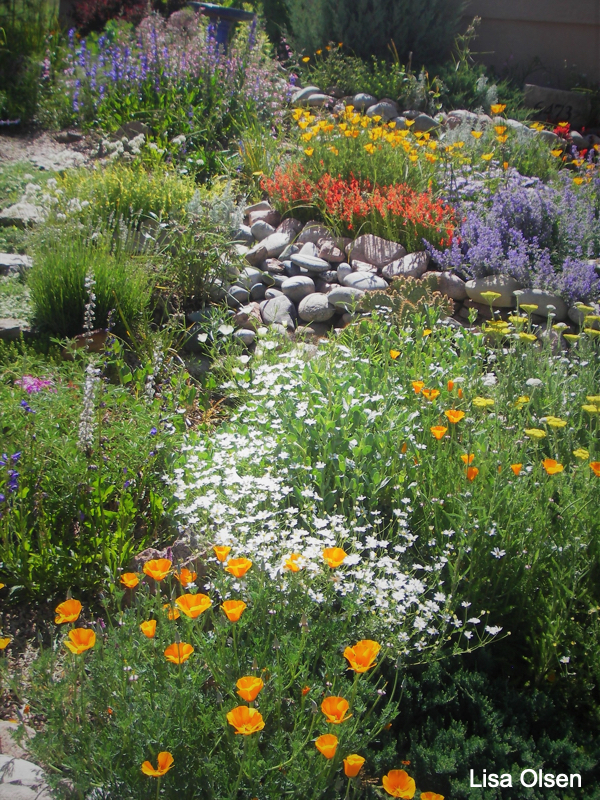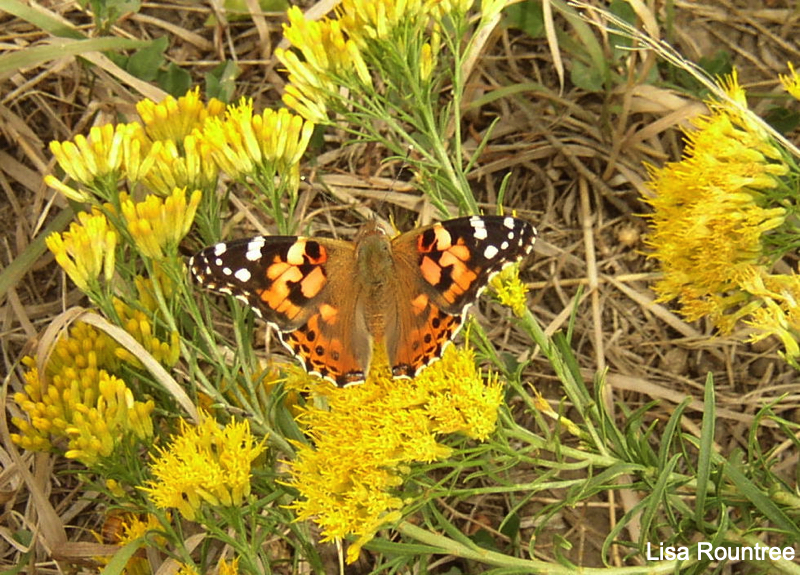By Deborah Lebow Aal
I know your interest is in native plants, and I’ll get there, but I will presume if you are reading this, that you are also interested in ecosystem issues and maybe even what steps you can take with your landscape to combat climate change.
I recently read a wonderful post by Anne-Marie Bonneau, Zero-Waste Chef, entitled “Want to combat climate change? Pick up your damn socks.” The title alone was worth repeating. So, with kudos to Anne-Marie, I am using some of her article. Please check out her blog and articles at zerowastechef.com. It’s awesome.
At the beginning of the article, she answers a question about what is the most important thing to combat climate change. After scratching her head, and thinking that the topic was too big to answer, she realized the answer was clear… “Consume less.” She is so right. “At its core, the grassroots zero-waste movement rejects unbridled consumerism and plays an important role as we grapple with climate change.”* That’s the concept for zero-waste gardening as well.
What do we mean by zero-waste gardening? It is examining your landscaping inputs and outputs and finding ways to minimize both. Reduce things coming in from outside your yard, especially from far away, and reduce waste going out. In other words, be aware of where your inputs are coming from and how much energy is embedded in them.
So how does this zero-waste gardening thing work? We gardeners are presumably pre-selected to love nature. We are out there in all sorts of weather, dealing with insects and dirt under our fingernails (mine are truly never clean). And we love it. But, we as gardeners, are guilty of buying, buying, and buying some more, as we transform our backyards, and hopefully front yards, into the delight we dream of. We can still transform our yards into the delight we dream of and buy NOTHING. Okay, that’s extreme, but we can reduce by quite a bit what we buy, and still have a gorgeous and ecologically-transformative landscape that is helping combat climate change, instead of contributing to it.

So, I’ll highlight what I think are the no brainers. First, don’t buy plants in plastic pots shipped in from Mexico or California or who knows where! Most plants can be either divided or grown from seed, maybe even collected from your neighbor’s or friend’s property. Unless you want something rather exotic (which I don’t recommend), most plants are readily available. What you must have are gardener friends! Nurseries everywhere are cringing as I write this, but it’s true – you do not need to buy chocolate flower or any kind of sedum. Ask a friend! I wring my hands at plant sales where people are buying Russian sage. It’s a xeric plant, yes. But, first, it’s not native to the Front Range (put in leadplant instead!) and second, anyone who has one Russian sage plant has many and is happy to give the pups away.
Second, mulch. I make my own. Instead of buying mulch that comes packaged in plastic, trucked in, and often dyed with I don’t know what, make your own. Now, this is labor intensive. But it’s exercise, sort of, and it makes use of your yard waste that might otherwise go to the landfill. I use leaves and broken up branches and whatever yard debris I have, to make a very effective mulch. It’s not going to be uniform, and it’s not going to give you a manicured look. It will give you a very natural look.
Third, fertilizer. And here’s where we finally get into native plants. Native plants DO NOT need fertilizer. They don’t need compost or special soil, generally, either. So, again, instead of buying fertilizer in plastic containers or bags, coming from somewhere else, and often overused and ending up in our water supply, make your own or don’t use any. If you’re growing annual vegetables, that’s a whole different game, so see my tips below. If you find you have to use fertilizer, go organic, please!
Fourth, water. Again, native plants are winners! Plant plants in your landscape that are adapted to our ecosystem and need little to no additional irrigation. They do exist, and there are many beautiful options. In fact, many of our natives are not happy with too much water.
And, if you’re interested in more about why we should even contemplate zero-waste gardening, Anne-Marie paired two recent NY Times articles, which, had you read them, should have knocked your socks off, ecologically. The first article summed up the United Nation’s report on humans speeding mass extinction. And hot on its heels, the second summarized the International Panel on Climate Change’s report on cataclysmic climate change. If those reports didn’t completely depress you but make you want to help in any way you can, I don’t know what will. Anne-Marie then reported on what good Dads get away with. Okay, I digress, but please read her blog – it’s related, I promise!

Zero-Waste Gardening Tips
Conserve Water and Energy
- Design a landscape that requires minimal or no additional water. Think of water as a finite resource. Know how much you use!
- When designing, keep plants with like water requirements together
- Keep rainwater on your property – adjust downspouts so water doesn’t run onto the street, alley, or sidewalk, but waters your plants
- Buy plants propagated close by (for example, Harlequin’s Gardens in Boulder), not trucked in from Mexico or California
- Use as little gas-powered machinery as possible. If you need power tools, consider a tool-lending library or share tools with neighbors.
- Having your own vegetable garden can be a water and energy sink. Consider buying vegetables at a CSA at your local farmer’s market. It’s much more sustainable than your $25 tomato. (Really, if you calculate how much energy and water is required to grow each tomato in your backyard, let alone the $$ costs, you will find it not sustainable).
- If growing your own food, consider perennials. Why? Perennials actually enrich your soil, adding nutrients, whereas annuals deplete soil, requiring inputs. Examples include sea kale (Crambe maritima), rhubarb, asparagus, sorrel, and parsley.
Reduce Waste
- When planning a new landscape, assess existing plant material – keep what is still doing okay, mature, and xeric, and especially keep what is native
- Reduce yard waste going to the landfill. Make your own mulch – use leaves and twigs as a very effective mulch.
- If you are weeding, and your weeds have not gone to seed, consider throwing them back into the landscape rather than putting them in the trash
Ecosystem Help
- Plant Natives! So many reasons why! Do I need to explain here? You will be attracting more insects, butterflies, and birds to your yard, reduce water needs, and support the local ecosystem.
- Take out as much lawn as possible. Keep only minimal areas you need for walking on, kids, and dogs. Kentucky bluegrass lawns are an ecological dead zone and don’t make a lot of sense in Colorado.
- Do not use pesticides or herbicides! Weed by hand or embrace your weeds!
- Do not cut back perennials in the fall – allow them to stand all winter for winter food and shelter, and cut them back in early spring
- Leave bare soil for the bees – as you learned in our June newsletter, many of our native bees live under bare soil
- Protect your soil from compacting – don’t step on it especially when wet
- Have a large variety of plants – biodiversity is important
*Quote from Anne-Marie’s zero-waste chef blog entry: “Want to combat climate change? Pick up your damn socks.” I might have added to take fewer air trips and eat less meat to the response of what the biggest things an individual can do to combat climate change, but they fall under the umbrella of consuming less.
Curious to learn more about transforming your garden into a habitat with Colorado native wildflowers, grasses, shrubs, and trees? Check out our native gardening toolkit, register for an upcoming event, subscribe to our newsletter, and/or become a member – if you’re not one already!
